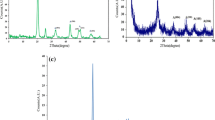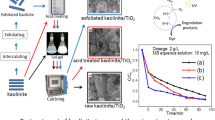Abstract
Photocatalysis is one of the most important process and was used to eliminate various organic pollutants as phenol in water. In this research study, a new composite containing Kaolinite, cement, and wood fibers modified by titanium oxide TiO2 was elaborated in order to be used in addition of building materials, as photocatalyst for the degradation of phenol. Different kinds and amounts of TiO2 (PC500, P90, and C-TiO2) were immobilized by a simple method inside the composite materials based. The matrix of the hybrid materials was characterized by Fourier transform infrared (FTIR) spectroscopy, X-ray diffraction (XRD), N2 adsorption-desorption (BET), and scanning electron microscope (SEM). These investigations confirmed the dispersion of titania in the new composite materials. The FTIR result has shown that clay particles were successfully treated before their insertion in the composite, by the appearance of two peaks at 2921–2851 cm-1. The XRD results reveal the identification of crystalline phase of TiO2 as anatase. The photocatalytic activity of the composite materials was investigated towards degradation of phenol in aqueous solution under UV light irradiation (369 nm). It has been found that photocatalytic efficiency was significantly enhanced when TiO2 is added. The highest photocatalytic activity has been shown by 3% P90-comp of 41.65% in comparison with 3% PC500 and 3% C-TiO2 which are 29.88% and 22.64 %, respectively. It was shown that the experimental data of kinetic reaction are well fitted by first-order model.













Similar content being viewed by others
Data availability
Most of the data generated or analyzed during this study are included in this published article. However, the corresponding author can provide the editor with additional information if requested.
References
Adepu AK, Siliveri S, Chirra S, Goskula S, Gujjula SR, Anumula R, Narayanan V (2020) A novel porous Fe3O4/Titanosilicate/g-C3N4 ternary nanocomposites: synthesis, characterization and their enhanced photocatalytic activity on Rhodamine B degradation under sunlight irradiation. J Water Process Eng 34(October 2019):101141. https://doi.org/10.1016/j.jwpe.2020.101141
Al Sawah MA, Richard D, De Bellefon C, Chovelon JM, Ferronato C (2010) Dégradation photocatalytique des ions ammonium en présence de TiO2 dopé. Comptes Rendus Chimie 13(5):502–507. https://doi.org/10.1016/j.crci.2009.12.004
Aloulou F, Alila S (2018) Preparation and evaluation of the influence of modified fiber flour wood on the properties of the fresh condition of cement–based mortars. Int J Ind Chem 9:265–276. https://doi.org/10.1007/s40090-018-0155-2
Aloulou F, Alila S, Sammouda H (2019a) Stabilization and evaluation of modified nanofiber flour wood on the properties of cement-baszd mortar. J Renew Mater 7(8):763–774. https://doi.org/10.32604/jrm.2019.04071
Aloulou F, Sabrine A, Sammouda H (2019b) Influence and dispersion of nanofiber of wood modified on properties of cement based mortars. J Renew Mater 7(7):631–641. https://doi.org/10.32604/jrm.2019.04070
Baghriche O, Rtimi S, Pulgarin C, Roussel C, Kiwi J (2013) ,RF-plasma pretreatment of surfaces leading to TiO2 coatings with improved optical absorption and OH-radical production” [Appl. Catal. B: Environ. 130-131 (2013) 65-72]. Appl Catal B Environ 142–143:892–895. https://doi.org/10.1016/j.apcatb.2013.07.014
Barama S, Davidson A, Barama A, Boukhlouf H, Casale S, Calers C, Brouri D, Domingos C, Djadoun A (2017) Dephosphatation under UV light of water by Ti-PILC with activation by secondary species (La, Se, and Rb). Comptes Rendus Chimie 20(1):7–19. https://doi.org/10.1016/j.crci.2016.05.017
Betega L, Paiva D, Rita A, Valenzuela FR (2008) Applied clay science organoclays : properties, preparation and applications. Appl Clay Sci 42(1–2):8–24. https://doi.org/10.1016/j.clay.2008.02.006
Byrne C, Subramanian G, Pillai SC (2017) Recent advances in photocatalysis for environmental applications. J Environ Chem Eng (November 2016):0–1. https://doi.org/10.1016/j.jece.2017.07.080
Carpio, E., Zúñiga, P., Ponce, S., Solis, J., Rodriguez, J., & Estrada, W. (2005). Photocatalytic degradation of phenol using TiO2 nanocrystals supported on activated carbon. J Mol Catal A Chem, 228(1-2 SPEC. ISS.), 293–298. https://doi.org/10.1016/j.molcata.2004.09.066
Costa TCDC, Melo JDD, Paskocimas CA (2013) Thermal and chemical treatments of montmorillonite clay. Ceram Int 39(5):5063–5067. https://doi.org/10.1016/j.ceramint.2012.11.105
Djellabi R, Yang B, Wang Y, Cui X, Zhao X (2019) Carbonaceous biomass-titania composites with Ti–O–C bonding bridge for efficient photocatalytic reduction of Cr(VI) under narrow visible light. Chem Eng J 366(January):172–180. https://doi.org/10.1016/j.cej.2019.02.035
Fatimah I (2014) Composite of TiO2 -montmorillonite from Indonesia and its photocatalytic Properties in Methylene Blue and E. coli Reduction. J Mater Environ Sci 3(5)(2012):983–992
Fatimah I, Fadillah S, Yulan (2018) TiO2 supported on brick waste as low cost photocatalyst for dye photodegradation. Chem Eng Trans 63:733–738. https://doi.org/10.3303/CET1863123
Folli A, Pochard I, Nonat A, Jakobsen UH, Shepherd AM, Macphee DE (2010) Engineering photocatalytic cements: understanding TiO2surface chemistry to control and modulate photocatalytic performances. J Am Ceram Soc 93(10):3360–3369. https://doi.org/10.1111/j.1551-2916.2010.03838.x
Hayati F, Isari AA, Fattahi M, Anvaripour B, Jorfi S (2018) Photocatalytic decontamination of phenol and petrochemical wastewater through ZnO/TiO2 decorated on reduced graphene oxide nanocomposite: influential operating factors, mechanism, and electrical energy consumption. RSC Adv 8(70):40035–40053. https://doi.org/10.1039/c8ra07936f
Hosseini SN, Borghei SM, Vossoughi M, Taghavinia N (2007) Immobilization of TiO2 on perlite granules for photocatalytic degradation of phenol. Appl Catal B Environ 74(1–2):53–62. https://doi.org/10.1016/j.apcatb.2006.12.015
Hu X, Sun Z, Song J, Zhang G, Zheng S (2018) Facile synthesis of nano-TiO2/stellerite composite with efficient photocatalytic degradation of phenol. Adv Powder Technol 29(7):1644–1654. https://doi.org/10.1016/j.apt.2018.03.030
Huang M, Xu C, Wu Z, Huang Y, Lin J, Wu J (2008) Photocatalytic discolorization of methyl orange solution by Pt modified TiO2 loaded on natural zeolite. Dyes Pigments 77(2):327–334. https://doi.org/10.1016/j.dyepig.2007.01.026
Liu Y, Zhu Y, Xu J, Bai X, Zong R, Zhu Y (2013) Degradation and mineralization mechanism of phenol by BiPO4 photocatalysis assisted with H2O2. Appl Catal B Environ 142–143:561–567. https://doi.org/10.1016/j.apcatb.2013.05.049
Madyan OA, Fan M, Feo L, Hui D (2016) Enhancing mechanical properties of clay aerogel composites: an overview. Compos Part B 98:314–329. https://doi.org/10.1016/j.compositesb.2016.04.059
Martinez-Haya R, Luna MM, Hijarro A, Martinez-Valero E, Miranda MA, Marin ML (2019) Photocatalytic degradation of phenolic pollutants using N-methylquinolinium and 9-mesityl-10-methylacridinium salts. Catal Today 328(January):243–251. https://doi.org/10.1016/j.cattod.2019.01.045
Mehta A, Mishra A, Sharma M, Singh S, Basu S (2016) Effect of silica/titania ratio on enhanced photooxidation of industrial hazardous materials by microwave treated mesoporous SBA-15/TiO2 nanocomposites. J Nanopart Res 18(7). https://doi.org/10.1007/s11051-016-3523-x
Milosevic I, Jayaprakash A, Greenwood B, Van Driel B, Rtimi S, Bowen P (2017) Synergistic effect of fluorinated and n doped TiO2nanoparticles leading to different microstructure and enhanced photocatalytic bacterial inactivation. Nanomaterials 7(11). https://doi.org/10.3390/nano7110391
Mishra A, Mehta A, Sharma M, Basu S (2017) Enhanced heterogeneous photodegradation of VOC and dye using microwave synthesized TiO 2 / Clay nanocomposites : a comparison study of different type of clays. J Alloys Compd 694:574–580. https://doi.org/10.1016/j.jallcom.2016.10.036
Mogyorósi K, Farkas A, Dékány I, Ilisz I, Dombi A (2002) TiO2-based photocatalytic degradation of 2-chlorophenol adsorbed on hydrophobic clay. Environ Sci Technol 36(16):3618–3624. https://doi.org/10.1021/es015843k
Moqbel RA, Gondal MA, Qahtan TF, Dastageer MA (2018) Pulsed laser synthesis in liquid of efficient visible-light-active ZnO/rGO nanocomposites for improved photo-catalytic activity. Mater Res Express 5(3). https://doi.org/10.1088/2053-1591/aab6ec
Mousli C, Jouini M, Kadri, Chehimi (2019) Polyaniline-grafted RuO2-TiO2 heterostructure for the catalysed degradation of methyl orange in darkness. Catalysts 9(7):578. https://doi.org/10.3390/catal9070578
Oblak R, Kete M, Štangar UL, Tasbihi M (2018a) Alternative support materials for titania photocatalyst towards degradation of organic pollutants. J Water Process Eng 23(December 2017):142–150. https://doi.org/10.1016/j.jwpe.2018.03.015
Oblak R, Kete M, Tasbihi M (2018b) Alternative support materials for titania photocatalyst towards degradation of organic pollutants. J Water Process Eng 23(December 2017):142–150. https://doi.org/10.1016/j.jwpe.2018.03.015
Pacheco-Torgal F, Jalali S (2011) Nanotechnology: advantages and drawbacks in the field of construction and building materials. Constr Build Mater 25(2):582–590. https://doi.org/10.1016/J.CONBUILDMAT.2010.07.009
Rachel A, Sarakha M, Subrahmanyam M, Boule P (2002) Comparison of several titanium dioxides for the photocatalytic degradation of benzenesulfonic acids. Appl Catal B Environ 37(4):293–300. https://doi.org/10.1016/S0926-3373(02)00006-1
Rahman A, Ching YC, Ching KY, Awanis N, Chakraborty AK, Chuah CH, Liou N-S (2015) Surface modification of natural fiber using Bi2O3/TiO2 composite for photocatalytic self-cleaning. BioResources 10(4). https://doi.org/10.15376/biores.10.4.7405-7418
Shanmugam, S. R. (2014). Photocatalytic degradation of phenol and phenol derivatives using a nano-TiO2 Catalyst: integrating quantitative and qualitative factors using response surface methodology. 1785–1806. https://doi.org/10.3390/w6061785
Steiner MG (2017) Photocatalytic decomposition of phenol under visible and UV light utilizing titanium dioxide based catalysts. Honors Theses and Capstones. 350. https://scholars.unh.edu/honors/350
Touati A, Jlaiel L, Najjar W, Sayadi S (2019) Photocatalytic degradation of sulfur black dye over Ce-TiO2 under UV irradiation: removal efficiency and identification of degraded species. Euro-Mediterr J Environ Integr 4(1). https://doi.org/10.1007/s41207-018-0086-5
Turkten N, Cinar Z, Tomruk A, Bekbolet M (2019) Copper-doped TiO 2 photocatalysts: application to drinking water by humic matter degradation. Environ Sci Pollut Res 36096–36106. https://doi.org/10.1007/s11356-019-04474-x
Uǧurlu M, Karaoǧlu MH (2009) Removal of AOX, total nitrogen and chlorinated lignin from bleached Kraft mill effluents by UV oxidation in the presence of hydrogen peroxide utilizing TiO2 as photocatalyst. Environ Sci Pollut Res 16(3):265–273. https://doi.org/10.1007/s11356-008-0044-x
Wang Y, Yang W, Chen X, Wang J, Zhu Y (2018) Photocatalytic activity enhancement of core-shell structure g-C3N4@TiO2 via controlled ultrathin g-C3N4 layer. Appl Catal B Environ 220:337–347. https://doi.org/10.1016/j.apcatb.2017.08.004
Wang X, Sun Y, Yang L, Shang Q, Wang D, Guo T, Guo Y (2019) Novel photocatalytic system Fe-complex/TiO2 for efficient degradation of phenol and norfloxacin in water. Sci Total Environ 656:1010–1020. https://doi.org/10.1016/j.scitotenv.2018.11.419
Xing Z, Zhang J, Cui J, Yin J, Zhao T, Kuang J, Xiu Z, Wan N, Zhou W (2018) Recent advances in floating TiO2-based photocatalysts for environmental application. Appl Catal B Environ 225. Elsevier B.V. https://doi.org/10.1016/j.apcatb.2017.12.005
Acknowledgements
The authors would like to acknowledge the Erasmus+ KA 107 project and the FP7FP4BATIW Euro-Mediterranean project for their financial support.
Author information
Authors and Affiliations
Contributions
Latifa Morjène: PhD student: Investigation (carried out most of the laboratory experiments) writing – original draft.
Fadhel Aloulou: Assistant professor: Supervision of the first part of the work especially the elaboration of the composite material.
Minoo Tasbihi: Assistant professor: Investigation (helped enormously in the characterization of the composite materials as well as in the photocatalysis tests in Berlin)
Michael Schwarze: Professor: Investigation (helped enormously in the characterization of the composite materials as well as in the photocatalysis tests in Berlin)
Reinhard Schomaecker: Professor: Validation, visualization and writing – review & editing
Mongi Seffen: Professor: Validation, visualization and writing – review & editing
Corresponding author
Ethics declarations
Ethics approval
Not applicable.
Consent to participate
Not applicable.
Consent for publication
Not applicable.
Competing interests
The authors declare no competing interests.
Additional information
Responsible Editor: Sami Rtimi
Publisher’s note
Springer Nature remains neutral with regard to jurisdictional claims in published maps and institutional affiliations.
Supplementary Information
ESM 1
(DOCX 57 kb)
Rights and permissions
About this article
Cite this article
Morjène, L., Aloulou, F., Tasbihi, M. et al. New composite material based on Kaolinite, cement, TiO2 for efficient removal of phenol by photocatalysis. Environ Sci Pollut Res 28, 35991–36003 (2021). https://doi.org/10.1007/s11356-021-13150-y
Received:
Accepted:
Published:
Issue Date:
DOI: https://doi.org/10.1007/s11356-021-13150-y




